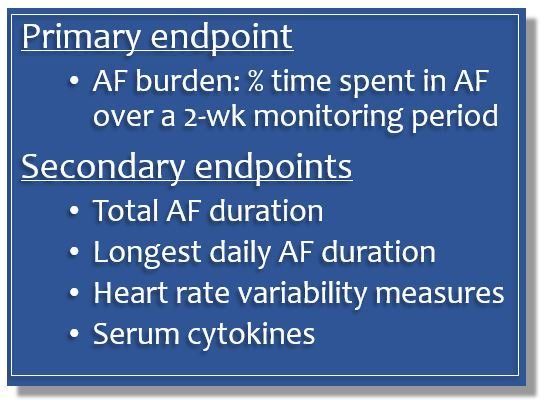Article
Transcutaneous Vagus Nerve Stimulation Significantly Reduces Atrial Fibrillation
Author(s):
SAN FRANCISCO― Results of the TREAT-AF trial showed burden of AF was reduced by 85% at 6 months using transcutaneous electrical stimulation of the vagus nerve, vs a sham procedure; findings were showcased at the 40th HRS Scientific Sessions.
Figure. TREAT-AF endpoints (please click to enlarge)

SAN FRANCISCOâ Burden of atrial fibrillation (AF) was reduced by 85% at 6 months by transcutaneous electrical stimulation of the vagus nerve, compared to a sham procedure.1 The finding was reported by Stavros Stavrakis, MD, PhD, associate professor of medicine in the Heart Rhythm Institute at the University of Oklahoma Health Sciences Center in Oklahoma City, at a May 9th session during the 40th Heart Rhythm Scientific Sessions in San Francisco.
AF represents the most common clinical arrhythmia in humans, attended by increases in morbidity and mortality as well as by deficits in quality of life. Previous studies have shown that vagus nerve stimulation (VNS) can suppress AF in animals and a proof-of-concept study in humans showed that 1 hour of low-level transcutaneous electrical stimulation (LLTS) of the auricular branch of the vagus nerve at the tragus of the ear significantly reduced atrial fibrillation duration and levels of serum inflammatory cytokines.2
Speaking on behalf of the investigators from the TRanscutaneous Electrical vAgus nerve sTimulation to suppress Atrial Fibrillation (TREAT-AF) trial, Dr Stavrakis presented data from the sham controlled double-blind randomized trial showing that VNS reduced all measures of AF burden at 3 and 6 months, as well as both daily and total AF duration vs a sham procedure. Median AF burden was reduced by 75% in the active vs sham treatment arm. LLTS also modified heart rate variability and reduced the level of TNF-α cytokines, although there were no significant between-group differences in other types of cytokines. See primary and key secondary endpoints in Figure above.
For the current randomized control trial, 26 patients with paroxysmal AF self-administered active electrical stimulation just below the discomfort threshold (20Hz) via an ear clip attached to the for 1 hour daily for 6 hours, and 27 administered sham therapy via the ear lobe. Mean age of the participants was 65 years.
Two patients in the sham group and one in the active therapy group died during the trial, none from cardiovascular causes. No device-related adverse effects were reported.
Dr Stavrakis closed by stating that further studies are indicated to optimize patient selection and discriminate at baseline between responders and nonresponders to maximize efficacy of this modality.
REFERENCES
Stavrakis S, Stoner JA, Humphre MB, et al. Transcutaneous electrical vagus nerve stimulation to suppress atrial fibrillation (TREAT-AF): a randomized clinical trial. In: Heart Rhythm Society Annual Scientific Sessions: Late Breaking Clinical Trials Session 1; May 8-11, 2019; San Francisco. S-LBCT01-01.
Stavrakis S, Humphrey MB, Scherlag BJ, et al. Low-level transcutaneous electrical vagus nerve stimulation suppresses atrial fibrillation. J Am Coll Cardiol 2015;65:867-875.





